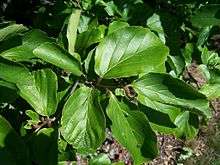Parrotia
| Persian ironwood | |
|---|---|
 | |
| Specimen planted in Belgium | |
| Scientific classification | |
| Kingdom: | Plantae |
| (unranked): | Angiosperms |
| (unranked): | Eudicots |
| (unranked): | Core eudicots |
| Order: | Saxifragales |
| Family: | Hamamelidaceae |
| Genus: | Parrotia C.A.Mey. |
| Species: | P. persica |
| Binomial name | |
| Parrotia persica (DC.) C.A.Mey. | |
Parrotia persica (commonly called Persian ironwood) is a deciduous tree in the family Hamamelidaceae, closely related to the witch-hazel genus Hamamelis. It is native to northern Iran and other parts of Iran (where it is called Dəmirağac) and it is endemic in the Alborz mountains.
Another species Parrotia subaequalis[1] (commonly called Chinese ironwood) originates from eastern China. There are five disjunct populations of Parrotia subaequalis in eastern China: two each in Jiangsu and Zhejiang provinces (Huang et al. 2005)[2] and one in Anhui (Shao and Fang 2004).[3] A full account of this sibling species can be found in an article: 'The Chinese Parrotia: A Sibling Species of the Persian Parrotia' by Jianhua Li and Peter Del Tredici.[4]
This species is listed as critically endangered by the IUCN (under its former name of Shaniodendron subaequale, which is no longer an accepted name for the species) P. subaequalis is also considered critically endangered (Grade I Key protected Wild Plant) in the China Red Data Book, with a very narrow distribution range. The five known relict populations of P. subaequalis comprise no more than 100 reproductive individuals. Therefore, this species has high conservation priority.

Parrotia is named for the German naturalist Friedrich Parrot.[5]
Description
It grows to 30 m (98 ft) tall and 8–15 m (26–49 ft) broad, with a trunk up to 150 cm (59 in) in diameter. The bark is smooth, pinkish-brown flaking/peeling to leave cinnamon, pink, green, and pale yellow patches in a similar manner to plane trees. The leaves are alternate, ovoid, often slightly lop-sided, 6–15 cm (2–6 in) long and 4–10 cm (2–4 in) across, with wavy margins; they are glossy green, turning a rich purple to brilliant red in autumn.
The flowers are somewhat similar to witch-hazel flowers but dark red; they are likewise produced in late winter on bare stems, but differ in having only four rounded sepals with no petals; the stamens are however fairly conspicuous, forming a dense red cluster 3–4 mm (1⁄8–3⁄16 in) across. The fruit is a two-parted capsule containing two seeds, one in each half.[6]
The richness of Iran's flora and the variety of its vegetation results from the variety and richness of its physical-geographic and natural-historic conditions and from its compound history influenced by the remote florist regions.
Relict genera of the tertiary period can be frequently found in all the zones of North of Iran especially in Talysh. They are the Persian Iron tree (Parrotia persica), the Lenkoran acacia (Albizzia julibrissin), the basket oak (Quercus castaneifolia), the Caucasian persimmon (Diospyrus lotus), the evergreen shrub of Ruscus hyrcana, the box tree (Buxus hyrcana), etc. There are 240 endemic species of plants in North and North West of Iran and also south-east of Azerbaijan.

Fossil record
Among the middle Miocene Sarmatian palynoflora from the Lavanttal Basin Austria researchers have recognized Parrotia fossil pollen. The sediment containing the Parrotia fossil pollen had accumulated in a lowland wetland environment with various vegetation units of mixed evergreen/deciduous broadleaved/conifer forests surrounding the wetland basin. Key relatives of the fossil taxa found with Parrotia are presently confined to humid warm temperate environments, suggesting a subtropical climate during the middle Miocene in Austria.[7]
Companies
There are several company names which are taken from Parrotia tree.One of the popular company about Parrotia is Parrotias.com Classifieds website and official logo of this platform was designed according to the Parrotia tree's colors.[8]
Cultivation
P. persica is cultivated as an ornamental tree for its stunning autumn colour and the smooth, patterned bark.[9]
Several cultivars have been selected for garden planting:
- 'Horizontalis': semi-weeping, wide-spreading horizontal branching pattern.
- 'Pendula' (Kew Form): Compact, weeping, quite graceful
- 'Select': Young leaves have purple margins, otherwise same as species
- 'Vanessa': Upright, columnar habit

Gallery
 February Flowers, Muséum de Toulouse
February Flowers, Muséum de Toulouse September leaves
September leaves- Bark of Parrotia persica in Botanical Garden Jevremovac
References
- ↑ "Parrotia subaequalis in Flora of China @ efloras.org".
- ↑ Huang, S., Y. Fang, Y. Peng, J. Yan, and S. Fang. 2005. The niche study of Shaniodendron subaequale population of Longchi mountain. Journal of Central South Forestry University 25: 80–83.
- ↑ Shao, X. F. and G. F. Fang. 2004. Habitat survey and ex situ conservation of Shaniodendron subaequale. Journal of Anhui Forest Science and Technology 2: 12–13.
- ↑ http://arnoldia.arboretum.harvard.edu/pdf/articles/2008-66-1-the-chinese-parrotia-a-sibling-species-of-the-persian-parrotia.pdf
- ↑ Coombes, Allen J. (2012). The A to Z of plant names. USA: Timber Press. p. 312. ISBN 9781604691962.
- ↑ Shorter Oxford English dictionary, 6th ed. United Kingdom: Oxford University Press. 2007. p. 3804. ISBN 0199206872.
- ↑ Combined LM and SEM study of the middle Miocene (Sarmatian) palynoflora from the Lavanttal Basin, Austria: part III. Magnoliophyta 1 – Magnoliales to Fabales, Friðgeir Grímsson, Barbara Meller, Johannes M. Bouchal & Reinhard Zetter, Grana 2015, Vol 54, No. 2,85-128.
- ↑ "Parrotias Classifieds". Retrieved 18 September 2016.
- ↑ "RHS Plant Selector - Parrotia persica". Retrieved 25 May 2013.
External links
![]() Media related to Parrotia persica at Wikimedia Commons
Media related to Parrotia persica at Wikimedia Commons